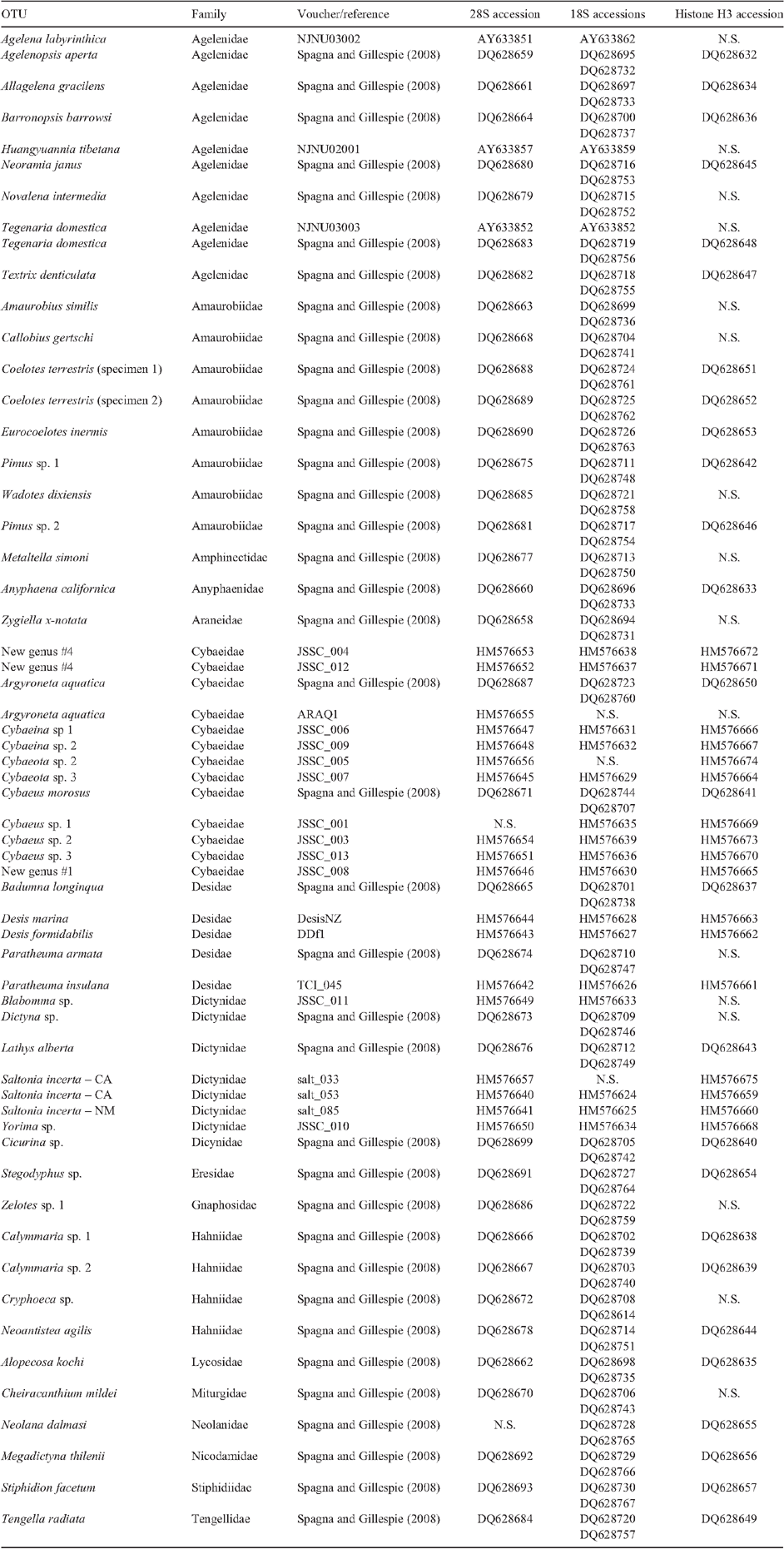Patterns of habitat affinity and Austral/Holarctic parallelism in dictynoid spiders (Araneae : Entelegynae)
Joseph C. Spagna A D , Sarah C. Crews B C and Rosemary G. Gillespie BA Department of Biology, William Paterson University, 300 Pompton Road, Wayne, NJ 07470, USA.
B Division of Organisms and Environment, University of California, Berkeley, 137 Mulford Hall, Berkeley, CA 94720-3114, USA.
C Present address: Berkeley City College, Department of Sciences, 2050 Center Street, Berkeley, CA 94709, USA.
D Corresponding author. Email: SpagnaJ@wpunj.edu
Invertebrate Systematics 24(3) 238-257 https://doi.org/10.1071/IS10001
Submitted: 8 January 2010 Accepted: 3 June 2010 Published: 30 August 2010
Abstract
The ability to survive in a terrestrial environment was a major evolutionary hurdle for animals that, once passed, allowed the diversification of most arthropod and vertebrate lineages. Return to a truly aquatic lifestyle has occurred only rarely among terrestrial lineages, and is generally associated with modifications of the respiratory system to conserve oxygen and allow extended periods of apnea. Among chelicerates, in particular spiders, where the circulatory system also serves as a hydrostatic skeleton, very few taxa have exploited aquatic environments, though these environments are abundant and range from freshwater ponds to the marine intertidal and relictual (salt) lakes. The traditional systematic positions of the taxa inhabiting these environments are controversial. Partitioned Bayesian analysis using a doublet model for stems in the nearly complete 18S rRNA gene (~1800 nt) and in the D2 and D3 regions of the 28S rRNA gene (~690 nt), and standard models for loops and full protein-coding histone H3 (349 nt) partitions (totalling 3133 bp when aligned) of dictynoid spiders and related lineages revealed that the only truly aquatic spider species, Argyroneta aquatica (Clerck, 1767) (Cybaeidae Banks, 1892), belongs in a clade containing other taxa with unusual habitat affinities related to an aquatic existence, including occupation of semi-aquatic (intertidal) areas (Desidae Pocock, 1985: Paratheuma spp.) and highly alkaline salt-crusts (Dictynidae O. Pickard-Cambridge, 1871: Saltonia incerta (Banks, 1898)). In a contrasting pattern, other spiders that also occupy intertidal zones, including some other members of the family Desidae (Desis spp., Badumna longinqua (L. Koch, 1867)), are an independently derived clade found primarily in the southern hemisphere. Use of the doublet model reduced some branch-support values in the single-gene trees for rRNA data, but resulted in a robust combined-data phylogeny from 18S rRNA, 28S rRNA, and histone H3. This combination of results – reduction in support in single-gene trees and gain in support in combined-data trees –is consistent with use of the doublet model reducing problematic signal from non-independent base pairs in individual data partitions, resulting in improved resolution in the combined-data analyses.
Additional keywords: Argyroneta, Cybaeidae, Desidae, Dictynoidea, doublet modelling, intertidal habitats, Paratheuma, partitioned Bayesian analysis, Saltonia, secondary structure.
Acknowledgements
The authors would like to thank Charles Griswold, Joel Ledford and Brent Opell for loan of specimens crucial to this work. All new specimens were collected under appropriate permits. We thank Jim McGuire and Matt Brandley for use of and assistance with computing resources at UCB, and Mark Miller and Lucie Chan for assistance with the CIPRES web portal. We thank David Gilley for comments leading to many improvements in the manuscript. Funding for the project was provided by the Schlinger Foundation, with additional support from the Division of Insect Biology at UC Berkeley and the National Science Foundation (Grant # DGE 0231877).
Angelini D. R., Jockusch E. L.
(2008) Relationships among pest flour beetles of the genus Tribolium (Tenebrionidae) inferred from multiple molecular markers. Molecular Phylogenetics and Evolution 46, 127–141.
| Crossref | GoogleScholarGoogle Scholar | PubMed |
[Accessed 1 October 2009].
Griswold C. E.,
Coddington J. A.,
Platnick N. I., Forster R. R.
(1999) Towards a phylogeny of entelegyne spiders (Araneae, Araneomorphae, Entelegynae). The Journal of Arachnology 27, 53–63.
[Accessed 23 December 2009].
Miller J. A.,
Carmichael A.,
Ramírez M. J.,
Spagna J. C.,
Haddad C. R.,
Rezac M.,
Johannesen J.,
Kral J.,
Wang X.-P., Griswold C. E.
(2010) Phylogeny of entelegyne spiders: affinities of the family Penestomidae (NEW RANK), generic phylogeny of Eresidae, and asymmetric rates of change in spinning organ evolution (Araneae, Araneoidea, Entelegynae). Molecular Phylogenetics and Evolution 55, 786–804.
| Crossref | GoogleScholarGoogle Scholar | PubMed |
[Verified July 2010].
Opell B. D.
(1999) Changes in spinning anatomy and thread stickiness associated with the origin of orb-weaving spiders. Biological Journal of the Linnean Society. Linnean Society of London 68, 593–612.
| Crossref | GoogleScholarGoogle Scholar |
[Accessed April 10 2010].
Poinar G.,
Kerp H., Hass H.
(2007)
Palaeonema phyticum gen. n., sp. n. (Nematoda: Palaeonematidae fam. n.), a Devonian nematode associated with early land plants. Nematology 10, 9–14.
[Accessed 1 May 2008].
Zuker M.
(2003) Mfold web server for nucleic acid folding and hybridization prediction. Nucleic Acids Research 31, 3406–3415.
| Crossref | GoogleScholarGoogle Scholar | PubMed |


|

|


